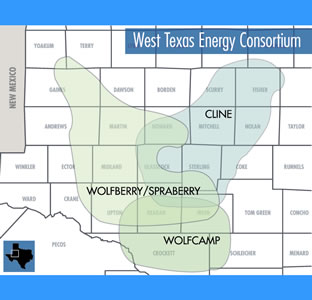UTSA Institute for Economic Development researches oil, gas economic impact

West Texas counties with oil and natural gas deposits

West Texas counties with oil and natural gas deposits
(Dec. 16, 2013) -- Development of oil and natural gas in a 16-county region of West Texas added more than $14.5 billion in total economic impact during 2012, according to a study released today by the Center for Community and Business Research in The University of Texas at San Antonio Institute for Economic Development. Additionally, the region supported 21,450 full-time jobs for workers in oil and gas, drilling, support operations, pipeline construction, refineries and petrochemicals.
Highlights of the UTSA study concluded that in 2012 the region generated:
- $1 billion in salaries and benefits paid to workers
- $6.2 billion in gross regional product (value added)
- $472 million in state revenue, including $187.4 million in severance taxes
- $447 million in local government revenue
The UTSA Center for Community and Business Research was contracted by the West Texas Energy Consortium (WTxEC) to estimate the economic impact of the oil and gas industry on certain counties in the consortium's area during 2012, and create a forecast for the year 2022. The consortium's area consists of the Concho Valley, West Central Texas and Permian Basin regions.
The region has a long history of oil and gas activity and, in recent years, has been affected not only by renewed attention in vertical wells but also new techniques such as horizontal drilling coupled with hydraulic fracture stimulation. The study estimates that nearly 854 vertical wells and 57 horizontal wells (including 12 directional wells) were completed in 2012.
"This baseline study is intended to help communities in West Texas plan and prepare for the prospect for increased oil and gas production in the area down the line. For many counties, activity is clearly in the early stages," said Thomas Tunstall, research director at the UTSA Institute for Economic Development and principal investigator for the study.
While taking into consideration low and high-price scenarios, the impact in 2022 could vary widely. But, UTSA estimates growth in full-time jobs supported by the oil and gas industry could potentially increase by 42.2 percent from 2012 to 2022. This study estimates a scenario where low oil prices in the future could produce an output as low as $7.6 billion, and where high oil prices could see enormous growth as high as $34.3 billion.
The ranges of these figures are broad due to high variability in the prices of oil and gas, the challenges of forecasting future oil and gas activities, changes in the number of wells per rig and changes in productivity per well.
The 16-county area researched encompassed various shales including the Cline Shale, a 70-mile wide by 140-mile long formation that stretches along 14 counties in West Texas. The formation produces natural gas, condensate, oil, and natural gas liquids, with margins more favorable than other shale plays.
The Center for Community and Business Research in the UTSA Institute for Economic Development conducts primary research on community and business development in South Texas and the border region. In addition to the study released today, the center has published Economic Impact of the Eagle Ford Shale (March 2013), Economic Impact of the Eagle Ford Shale (May 2012), Strategic Housing Analysis (July 2012, in partnership with the UTSA College of Architecture and UTSA Center for Urban and Regional Planning Research), Eagle Ford Shale Impact for Counties with Active Drilling (October 2012) and its Workforce Analysis for the Eagle Ford Shale (October 2012).
>> For more information, visit the IED Texas website. Read the full report.
>> Connect online with the Institute for Economic Development on Facebook or Twitter.
------------------
About the IED
The University of Texas at San Antonio (UTSA) Institute for Economic Development is dedicated to creating jobs, growing businesses and fostering economic development. Its 12 centers and programs provide professional business advising, technical training, research, and strategic planning for entrepreneurs, business owners and community leaders. Its programs serve San Antonio, the Texas-Mexico border area as well as regional, national and international stakeholders. Together with federal, state and local governments, and private businesses, the UTSA Institute for Economic Development fosters economic and community development in support of UTSA's community engagement mission.
About UTSA
The University of Texas at San Antonio (UTSA) is an emerging Tier One research institution specializing in health, energy, security, sustainability, and human and social development. With nearly 29,000 students, it is the largest university in the San Antonio metropolitan region. UTSA advances knowledge through research and discovery, teaching and learning, community engagement and public service. The university embraces multicultural traditions and serves as a center for intellectual and creative resources as well as a catalyst for socioeconomic development and the commercialization of intellectual property -- for Texas, the nation and the world.
Events
Have questions about making your OER accessible on UTSA Pressbooks? The OER Team and the Digital Accessibility Team are ready to answer them! Please bring your questions about OER and accessibility and receive guidance from our two teams.
Virtual EventCelebrate the graduates of the College for Health, Community and Policy, College of Liberal and Fine Arts and College of Sciences.
AlamodomeCome celebrate the graduates of the Alvarez College of Business, College of Education and Human Development, Klesse College of Engineering and Integrated Design and University College
Alamodome

